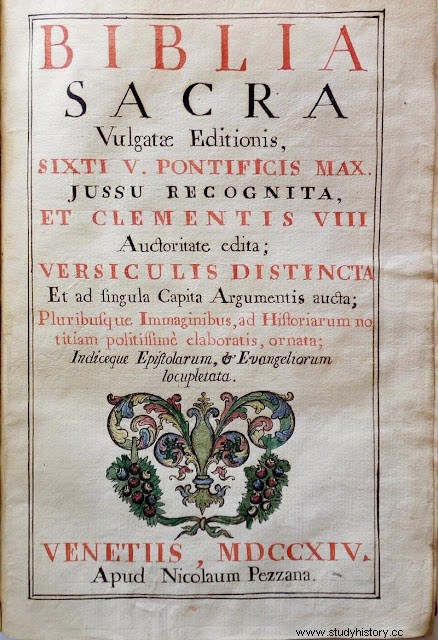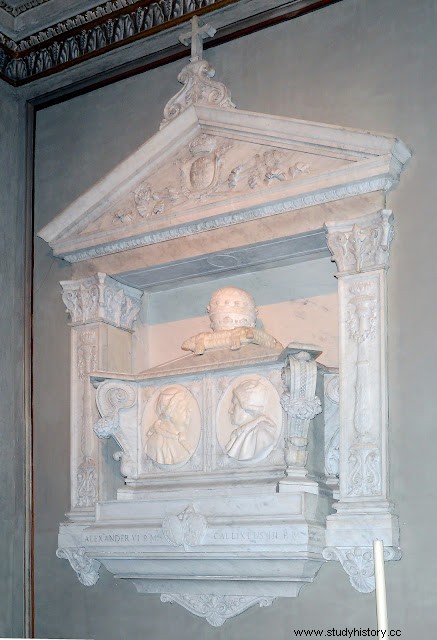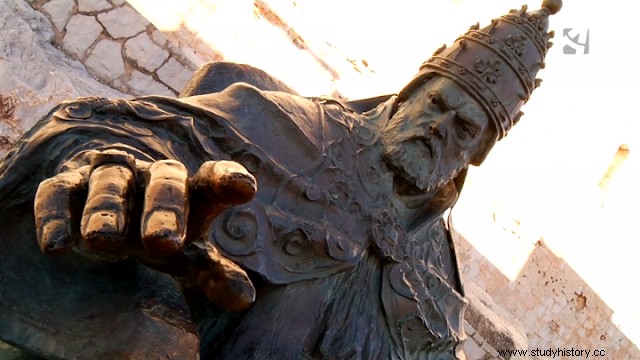Historical, social and cultural moments are always associated with the names of different popes. Were there Spanish potatoes? What was his legacy?

Of the 266 Popes recognized by the Catholic Church of Rome in these two thousand four years of history were Spanish:Dámaso (Pope number 37), Callistus III (209) and Alexander VI (214) and Benedict XIII (antipope).
These four Spaniards came to sit in the chair of Saint Peter and although in some cases the pontificate was clean and without any scandal, in others it was marked by political and ecclesiastical intrigues and suspicions of poisoning.
- Damasus I , The pope of Galician or Portuguese origin who translated the Bible into Vulgar Latin, which was used for 1,600 years.
 Damasus I
Damasus IDamasus was born in Roman Gallaecia, which is now Galicia and Portugal, but historians Spaniards consider him the first Spanish Pope. He was the 37th pope of the Catholic Church, from the year 366 until his death, in the year 384. He is the patron saint of archaeologists.
His pontificate has been the eighteenth longest in history with 18 years , 2 months and 11 days (a total of 6,646 days). His name day is celebrated on December 11. His name in Latin means 'tamer'. Saint Jerome was his secretary.
From the beginning of his pontificate, Damasus chose not to give in to other Christian doctrines, and focused on achieving unity and centrality in the church. The Roman Empire began to fracture, forming an empire in the West and another in the East, which configured the Church as a link between both parties. In addition, the figure of the emperor was consolidated in the Dominated, so he adopted a mystical form, legitimized and sent by God, who sought the centralism of power through the support of the Church.
On the other hand, the Church began to acquire the role of political director and vehicle and creator of the knowledge of the time, trying to unify the sciences and centralize power, rejecting as heresy everything magical, irrational or contrary to Christian authority; so it prevails over other doctrines.
Dámaso sent Jerome to carry out his revision of the earliest Hebrew versions of the Bible, he made a translation known as the Vulgate , which became popular because it was written in Latin. This version was approved by the Council of Trent in 1546, officially adopted in the liturgy and used by the Catholic Church for nearly fifteen centuries, replacing the Vetus Latina and causing Latin to become the main language of worship. br />
 The Latin translation of the Bible became the most widespread version, the so-called Vulgate.
The Latin translation of the Bible became the most widespread version, the so-called Vulgate.Damasus He died on December 11, 384, at the age of 80, after a pontificate of 18. In 1928, the Association for the Catacombs of San Dámaso, commissioned by the Holy See to preserve and excavate them, raised funds to defray the expenses of conservation and studies of the catacombs of San Dámaso, for which they requested the issuance of some stamps to the Spanish government and to the pontiff Pius XI.
- Calixtus III , considered a man of high ideals, of enormous courage, energy and perseverance. He realized the dangers facing Europe and made every effort to unite the Christian princes in the defense of their own countries and if he failed the fault was not with the pope but with those who refused to heed his advice.
 Calixtus III
Calixtus IIIBorn in Canals (Valencia) on December 31, 1378 and died in Rome on August 6, 1458 (age 71). Baptized in the parish of Xátiva. Ecclesiastic, jurist and diplomat, but above all Pope of the Catholic Church. Born with the secular name of Alfonso de Borja (Alfons de Borja). His remains are found in the Church of Santa María de Monserrat in Rome.
He began his studies in Xátiva and in Valencia where he studied Arts. He received a doctorate in canon law in 1411 and in civil law in 1414. In 1411 he was appointed canon of the Cathedral of Lérida.
Little by little he made a name for himself as a jurist and diplomat before the court of King Alfonso V the Magnanimous and before the papal court of Benedict XIII (antipope). He is the architect of the resignation in 1429 of Antipope Clement VIII, who took refuge in Peñíscola, which means the end of the Western Schism. This great success saw his great prestige catapulted, being appointed bishop of Valencia (between 1429-1458).
On May 2, 1444 he was appointed cardinal by Pope Eugenio IV when he succeeded in separating Alfonso V from the Council of Basel (Switzerland). From this moment he begins to reside in Rome and resigns from his charges at the court of Aragon. He will never set foot on Valencian soil again.
On April 8, 1455 he was elected Pope as a compromise solution to the various factions that disputed the miter of the late Pope Nicholas V. The new Pope will have as the axis of his policy abroad, the organization of a crusade against the Turks who, with the taking of Constantinople in 1453, endangered Europe. Also characteristic is his progressive estrangement from King Alfonso the Magnanimous, who occupied Naples in dispute with the French and with the interests of the Papacy. His former patron Alfonso V wanted the pope to recognize his illegitimate son Frederick as heir to the crown of Naples, which the pope refused.
 Calixtus III and Alexander VI tomb in Santa María de Montserrat, Rome.
Calixtus III and Alexander VI tomb in Santa María de Montserrat, Rome.As an anecdote we can tell that the "Angelus" that is prayed daily at twelve noon, was instituted by Pope Calixtus III as a reminder of the victory of Christian arms against the Turks who were besieging the city of Belgrade on July 21, 1456.
Another fundamental aspect in his papacy is the nepotism that he introduced in the Holy See. The nepotism or appointment of positions between relatives, with being a habitual practice in the Holy See, Calixto III elevated it to the superior category; one of the relatives that he placed was his nephew Rodrigo de Borja who years later would be elected Pope as Alexander VI. It is known that Calixtus III had a natural son before becoming Pope with a woman with an unknown name whose name was Francisco de Borgia and who died in Pisa in 1511.
On June 3, 1455, Pope Calixtus III canonized Saint Vincent Ferrer. According to a legend and it is nothing more than a legend, Saint Vincent Ferrer had prophesied in 1409 that he would be elected pope and that he himself would canonize him, as it happened. "You will be Pope and you will make me a saint This legend was told by Calixtus III himself to anyone who wanted to listen to it.
Also during his papacy, the case of the trial of Joan of Arc who had been burned in 1431 in Rouen (France) by the English was reopened; As a result of the investigation, it was determined that the process had been unfair and this made it possible for it to be elevated to the altars, although some centuries later.
- Alexander VI , he is one of the most controversial and remembered popes in history, not because his actions were very different from those of others who preceded or succeeded him, but because he did not try to hide them. He was a man far removed from the original message of Christ in his account of humility and austerity. The fact that he was not Italian would create many enemies for him.
 Alexander VI
Alexander VIXativa, January 1, 1431-Rome, August 18, 1503. was the 214th pope of the Catholic Church between 1492 and 1503. His birth name, in Valencian, was Roderic Llançol i de Borja1 (in Spanish known as Rodrigo de Borja and in Italian as Rodrigo Borgia). Son of Jofré de Borja y Escrivá and Isabel de Borja, sister of Alfonso de Borja, who was Bishop of Valencia and later Pope Calixtus III.
Rodrigo de Borja achieved and maintained power through nepotism, and rose within the hierarchy of the Catholic Church due to his relationship with Pope Calixtus III, who was his uncle. This family relationship facilitated his accession to Cardinal Deacon and the performance of numerous positions of great importance inside and outside the Roman Curia, which allowed him to gain political influence and prestige that, finally, led him to the pontifical throne in 1492.
Once elected Pope as Alexander VI, he triggered and became involved in dozens of political situations, involved in intrigues and in the stormy and treacherous relations between international powers. Through political alliances and conspiracies, he sought to consolidate his family within the Italian nobility and increase its power on every possible occasion, a task that he undertook together with his children, Juan, César, Lucrecia and Jofre, who served as instruments. of his political machinations.
Through the Italian War (1494-1498) and the Naples War (1501-1504) he managed not only to ensure his power, but to increase it, taking advantage of the rivalries between the powers of the time and the political tensions between the families of the European aristocracy, so that during the 11 years that his papacy lasted he managed to propel himself to the top of power in the Italian peninsula.
Tragically, the same intrigues and powers that served to bring the House of Borgia to the top ensured its destruction, for all the power the Borgias had gained, including the military success of Caesar Borgia, revolved around the Pontifical States. offices and therefore depended on the permanence of Alexander VI in power, for which the vast network of counties, principalities and territories that the Borgias had placed at his feet succumbed ipso facto with his death, sealing the fate of César Borgia, who He would die four years later in 1507, burying the Borgia era.
 Borgia Apartment, Resurrection of Christ with kneeling Pope Alexander VI (1492-1494).
Borgia Apartment, Resurrection of Christ with kneeling Pope Alexander VI (1492-1494).From According to the standards of his time, Rodrigo Borgia's ecclesiastical career was peculiar. He became a cardinal at 20 years of age, serving as Bishop of Valencia, and later Vice-Chancellor of Rome at just 22 years old, remaining in that position, until his election as pope.
The most severe denunciations against Alexander VI, for coming from the official sphere, are those of his Catholic contemporaries:Cardinal Giulliano Della Rovere, future Pope Julius II, the Augustinian Cardinal and reformer, Egidio of Viterbo, and the Oratorian Raynaldo. They accused him of having committed simony to achieve promotion to the "Pontifical Solium" and also of transgressing the ecclesiastical code, breaking celibacy by having a relationship with Julia Farnesio. Alexander VI was a man who loved sensual pleasures, a trait that he kept unchanged throughout his life.
- Benedict VIII , called Pedro Martínez de Luna y Pérez de Gotor (Illueca, November 25, 1328-Peñíscola, May 23, 1423), better known by the name of "Papa Luna", was pope in the obedience of Avignon and cardinal from December 1375. The tenacious fight that Pope Luna maintained against his enemies served to give rise to the popular phrase of "standing in his thirteen" in reference to Benedict XIII's refusal to resign his position as pope. On his death he was succeeded by Clement VIII.
 Benedict VIII, Pope Luna
Benedict VIII, Pope LunaBorn in Illueca, a town in what is now the province of Zaragoza, in Kingdom of Aragon, on November 25, 1328, was a member of the Luna family, one of the main Aragonese lineages, related to archbishops and kings.
Appointed cardinal by Pope Gregory XI in the turbulent years of the see Avignon, accompanied the pontiff when, at the request of Santa Catalina de Siena, he returned to Rome. Pope Gregory XI died during preparations for his return to Avignon, fleeing the conflicts and revolts in Rome.
The conclave to elect Gregory XI's successor began on April 7, 1378, with the presence of only 16 of the 22 cardinal electors, since the arrival of those who were in Avignon was not expected. Cardinal Pedro de Luna, together with Jean de Cros, proposed the election of the Archbishop of Bari, Bartolomeo Prignano, who was not a cardinal and therefore was not in the conclave, to please the Romans and to overcome the conflict between the two factions. French (Limousin and Gallican). So it was done, on April 8 Prignano was elected pope, he took the name of Urban VI.
Soon the character of Urban VI would show little diplomacy, which made several cardinals begin to feed the idea that his election could be declared null. Which Luna never agreed with.
After the arrival of the remaining cardinals who had not been able to go to Rome in time for the election of the pope, Pedro de Luna was consulted again about the legitimacy of the conclave and with the data provided canonically they convinced him that the election de Urbano had not been legal, since it had been voted, not out of conviction, but out of fear. On August 2, 1378, they signed a document in which they declared the election of the pope null and void, for the reasons stated.
 Sculpture of Benedict XIII in Peñíscola
Sculpture of Benedict XIII in PeñíscolaThe cardinals moved to Fondi, where on September 20 they they met in conclave and elected Robert of Geneva as pope, who took the name of Clement VII, who returned to Avignon. Pedro de Luna paid obedience to the new pope, being a participant in one of the most convulsive periods in the history of the Catholic Church, the Western schism. Pedro de Luna was legate of this pontiff for 16 years.
On the death of Clement VII, in 1394, Pedro de Luna was elected pontiff by 20 votes out of 21 and took the name of Benedict XIII. However, France opposed this new pope of Avignon who had shown not to be as manageable as his predecessors, and who was also a subject of the Crown of Aragon, for which it was difficult to force him to maintain loyalty to the French monarchy. In 1398, France finally withdrew its political and financial support for the papal seat of Avignon and Benedict XIII was pressured to resign, which Benedict XIII refused, alleging irreparable damage to the Church.
After a military blockade of the French on his papal palace in Avignon, Benedict XIII managed to flee the city in 1403, seeking refuge with Louis II of Naples. The end of French support meant that Portugal and Navarre also stopped recognizing him as pope, while 17 cardinals abandoned obedience to Avignon, leaving only five cardinals loyal to Benedict XIII. His papacy was now recognized only by the kingdoms of Castile, Aragon, Sicily (dynastically linked to the Crown of Aragon) and Scotland.
Although at one point there were three popes simultaneously (John XXIII, Gregory XII and himself), Benedict always argued that his papacy was the valid one since he was the only pope who had been elected cardinal before the Western Schism and, therefore, the only truly legitimate one. In 1406 Benedict XIII began talks with Gregory XII to resign jointly and unify the papal see, but this possibility failed when Benedict XIII insisted on its exclusive legitimacy.
Finally, the conciliarist theses, which defended that the council was superior to the pope, they triumphed, and, again refusing to resign, Benedict XIII was condemned at the Council of Constance in 1415 as a heretic and antipope, and deposed along with antipope John XXIII. While Pope Gregory XII of Rome resigned in favor of the unification of the Church. The Council appointed Martin V as sole pontiff.
 Peñíscola Castle
Peñíscola CastleThe antipope still enjoyed the protection of Alfonso V of Aragon for political reasons, but without real influence in the rest of Europe. He died on May 23, 1423, at the age of 94, in Peñíscola Castle, an ancient fortress of the Order of the Temple where he had transferred the papal seat.
